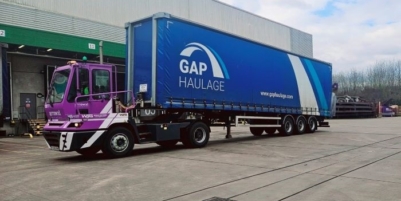-
Nutrivend selects Forterro’s Orderwise to support online expansion and streamline operations - April 11, 2025
-
ARROWXL LAUNCHES AMBITIOUS ZERO WASTE ROADMAP - April 8, 2025
-
THE BCMPA’S NEW CAMPAIGN DRIVES OUTSOURCING SUCCESS IN Q1 - April 7, 2025
-
BLACKOUT TECHNOLOGIES TARGETS TELEMATICS-INTEGRATED MOBILE DEVICE BLOCKING TO COMBAT SMARTPHONE DISTRACTION - April 1, 2025
-
OpenADR Alliance announces first OpenADR 3.0 certified products with EVoke Systems, E.ON Energy and Universal Devices - March 25, 2025
-
Growing fulfilment and contract packer appoints new Managing Director - March 25, 2025
-
When is it time to invest in a WMS? Understanding the key trigger points - March 25, 2025
-
eCapital helps Vantage Recruitment on its journey to financial success - March 24, 2025
-
Hugo Beck Celebrates 70 Years of Packaging Innovation with Open House Events - March 20, 2025
-
PROLOG FULFILMENT SUPPORTS LUNA DAILY’S COMMITMENT TO BETTER BODY CARE FOR ALL WOMEN - March 19, 2025
By Louisa Hosegood, Digital and Strategy Director at Bis Henderson Consulting

Supply chains today are required to deliver ever-better service levels while simultaneously bearing down on cost and meeting aggressive new sustainability agendas. This has to be achieved against a background of long-term fundamental changes in consumer behaviours, priorities and expenditure, and the shorter-term rolling turmoil of COVID. The supply chain is clearly, more than ever, a key factor in securing competitive advantage.
The current pandemic has spurred creativity and challenged some of the fundamental taboos of working together. We have seen glimpses of how collaboration can be vital to the retailer’s mission to offer customers the widest assortment, at the best prices, with assured availability.
So is collaboration the answer? Can partnerships and sharing be done effectively whilst still maintaining brand differentiation? The suggestion is, it certainly has a lot of potential and could offer a strategic route to profitability and sustainability, which should not be ignored.
This pandemic has created additional operating costs, whether through COVID-specific social distancing requirements and special cleaning measures, risk mitigation by changing product sourcing, or through an accelerated shift to eCommerce, requiring greater investment in people and assets – but with tighter margins.
Lower demand being seen in some retail sectors isn’t translating into the freeing up of scarce logistics assets – quite the reverse. ECommerce requires more warehousing, more trucks, more drivers and operatives, and more delivery vans – all of which are in short supply. The true number of empty or less than full (LTF) trucks running on UK roads is a great unknown but realistically, it’s likely to be high, and many warehouses operate at peaks and troughs, with lots of space one minute and rubber walls needed the next. Balancing need and capacity across supply chains through wider collaboration makes perfect sense.
Meanwhile, meeting sustainability agendas not only impose extra costs, through restrictions on vehicle movements and delivery times, low emission zones and carbon-related taxes, but also introduce a new form of cost accounting, as consumers demand to see the environmental footprint of their purchases. Waste is an underlying issue, and as long as companies run their supply chains in isolation, waste will continue to raise costs, impair service, and frustrate sustainability. Collaborative initiatives can cut waste, to the benefit of consumers and companies alike – improving operational efficiency, reducing cost and driving up service performance. So how do you achieve transformative environmental efficiencies on your own? Costs for a single organisation can be prohibitive but perhaps, there are simpler ways of achieving the same goal.
Collaboration can be horizontal, vertical, or both. Vertical collaboration, between a retailer, its logistics partners, and the various tiers of the supply chain, should be a ‘no-brainer’, but it is remarkable how businesses just don’t collaborate on the success of promotions, their future plans for marketing, or sharing even basic operational data, such as POS, in timely fashion. Greater vertical collaboration will allow much more effective use of logistics lanes and facilities. There is a caveat – collaboration must be both scalable (accessible to smaller players) and inclusive (no favourites) otherwise the competition authorities will have reasonable grounds to investigate.
Horizontal collaborations, especially between businesses that are to some extent competitors, can be even more contentious. But if a retailer wants to co-ordinate and consolidate deliveries there is no reason why it shouldn’t require suppliers – even competing brands – with LTF loads to share transport and warehousing arrangements. And if suppliers and 3PLs can collaborate over supply to one retailer, why should they not extend that to all the retail customers in an area. Does the consumer really care if the products of P&G and Unilever arrive at Tesco on the same truck? So why would they worry if the same truck has also dropped at Asda, Morrisons and Sainsburys? The consumer is motivated by product availability, price and social responsibility – not by how a delivery to store is configured.
Far from being banned under competition law, collaboration in future may be actively promoted or enforced by the authorities. For example, it is likely that in many urban areas, collaboration in store replenishment and last mile delivery through shared services from perhaps ‘edge of town’ transhipment centres, will be enforced through taxes, restrictive regulations, or both. Perhaps the owners of retail parks and shopping malls, or local councils responsible for High Streets and markets, themselves could play a role in facilitating a collaborative approach.
Supply chain collaboration has a lot to offer retailers, their partners, consumers and society itself.
Sharing fixed and mobile assets could reduce the investment required to maintain and improve service and could also offer a route for smaller companies to raise their game. In the current climate of switching to online, many retailers are re-assessing their physical estate and so inventive collaboration may find commercial solutions for “baggy space”.
Skilled labour, from logistics managers to drivers and warehouse technology specialists, is likewise a resource in short supply whose use must be optimised. Many smaller supply chains cannot attract or retain all the skills they require, or may need these skills on a less than full time basis. Collaboration can give everyone access to the talent.
Overhead costs such as IT can likewise be shared and a larger network will support more sophisticated solutions. Where supply chain operations come into apparent conflict with sustainability, environmental and other agendas, the ability of supply chain players to speak and act as one will tend to promote solutions that meet all stakeholders’ objectives.
Innovative approaches can be spread to mutual advantage, and a collaborative or partnership approach can make it easier, quicker and cheaper to move into new geographical or value-added service areas or to enter new markets and access new customer bases – no reinventing the wheel required.
Beyond that, collaboration can be viable even between businesses or supply chains that appear to be direct competitors – ‘co-opetition’. There are examples of retailers who have partnered with the great threat, Amazon – gaining exposure, albeit online, but with the expectation of maintaining footfall because they are a location to which Amazon customers can easily collect and return goods. The possibilities are endless.
Our experience at Bis Henderson Consulting as network creators and facilitators suggests that there is great potential for retailers and their partners to develop collaborative approaches, creating more economically and environmentally sustainable supply chains. We have found that the secrets to success lie as much in the attitudes and cultures of the participating companies, as in the physical ‘nuts and bolts’ of supply chain operations.
Significant collaboration does require attitudinal change, breaking down preconceptions and often ‘forgetting’ previous, perhaps adversarial, history. It needs a shared vision of aims and agendas, and of how all parties – including, of course, the consumer – will benefit. It requires willingness and trust to make data and plans available, and to volunteer it. There is a need for creative thinking and even some leaps of faith.
We are not suggesting this is straightforward. Businesses need to work together in an open-minded way to explore possibilities, and identify strengths, weaknesses, compatibilities, as well as additional potential partners. Converting the vision into workable commercial and operational agreements may also be challenging. As an independent and unbiased facilitator we can help assess strategies, identify opportunities for initial collaboration, help plot a roadmap for where this may or should lead in time, and help in bringing different parties together.
In an environment that is changing radically and rapidly, there is a strong case for supply chain collaboration, not just as a tactical convenience, but as an integral part of business strategy. Everyone is facing the same basic challenges – of rising costs, volatile and uncertain demand, fickle customers, resource scarcity, restrictive regulations, and a challenging sustainability agenda. Now is the time to leverage competitive advantage through collaboration. Contact Bis Henderson Consulting and let us help you find competitive advantage through collaborative relationships.

































